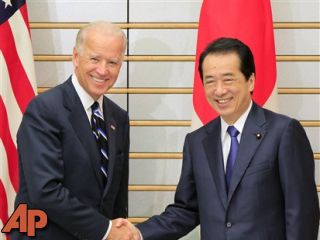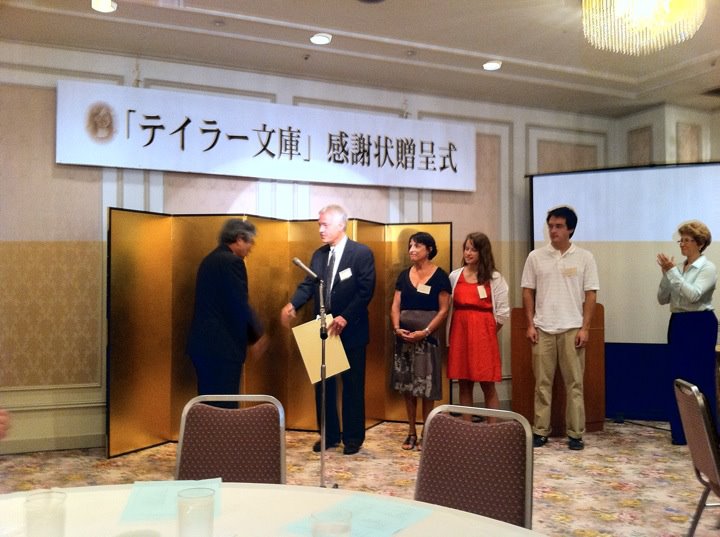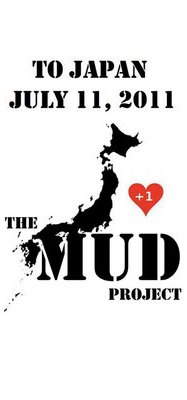Slate.com series: “Can Japan Recover?”
There’s an excellent ongoing series on Slate.com titled “Can Japan Recover?” by Daisann McLane as she travels through various areas of Tohoku. McLane is traveling and writing about Japan as a guest of the Japan National Tourism Organization (JNTO).
“I’m exploring recovering Japan as a guest of the Japan National Tourism Organization. Tourism here dropped through the floor in the first three months after what’s now being called the “Triple Disaster”—earthquake, tsunami, Fukushima. The tourism board was so eager for upbeat stories they offered to send me anywhere I wanted over the course of a week. I emailed them a decidedly non-upbeat itinerary: Sendai, Fukushima, Tokyo. To my surprise, and to their credit, they said no problem. A few weeks later, in July, I was on a Shinkansenspeeding north from Tokyo to Sendai.”
To read more of McLane’s writing about Japan on her travel blog, go to www.therealtravelblog.com.
Ishinomaki presents Anderson family with certificate of appreciation
***************
Posted to Facebook by AJET Chair Matt Cook (Osaka), who was in attendance:
“Ishinomaki city’s mayor presents Taylor Anderson’s family with a certificate of appreciation. To say this memorial was moving doesn’t do it justice.”
Asahi Shimbun article on Andy Anderson and his family’s efforts to support Ishinomaki
************
Thanks to JET alum Mark Flanagan for sharing this article:
“Taking over a daughter’s dream to bridge Japan and U.S.”
By HIROSHI ITO / Correspondent
September 3, 2011
Andy Anderson never expected he would find himself trying to fill his daughter’s shoes by acting as a bridge between the United States and Japan.
But that all changed after his daughter, Taylor, perished in the massive tsunami spawned by the March 11 Great East Japan Earthquake.
Anderson, 53, a realtor living in Midlothian, in the suburbs of Richmond in the U.S. state of Virginia, is determined to continue the work that his 24-year-old daughter started.
Taylor had been teaching English to a handful of elementary and junior high schools in Ishinomaki, a coastal city in Miyagi Prefecture that bore the brunt of the tsunami that devastated the Tohoku region.
She has been working as a teaching assistant since August 2008 under the Japan Exchange and Teaching Program, a Japanese government initiative known as the JET program. Read More
“A Perspective on Helping Japan Disaster Victims” by ex-JET Jeannie McKinney
This article titled “A Perspective on Helping Japan Disaster Victims“ recently appeared on the CleanEnergy.org website, written by Jeannie McKinney (Hokkaido, 2010-11) who is currently doing an internship for the Knoxville, TN office of the Southern Alliance for Clean Energy (SACE).
Link to original post: http://blog.cleanenergy.org/2011/08/30/helping-japan-disaster-victims/
Here’s an excerpt:
“Post-March 11th, the amount of willingness and enthusiasm, good will and generosity that came from abroad as well as at home, was honestly overwhelming. I was living in a small town in Hokkaido, the northernmost island and prefecture of Japan, at the time of the disaster, in an area that experienced nothing but a few tremors and shakes. But somehow, my community of 13,000 generated so many donation packages within the first few weeks after the disaster that our three little post offices had trouble handling the increased mail traffic. Instead, postal workers had to set out collection bins in their lobbies for the Japan Red Cross to come and pick up on their own.”
***********
“The problem is that there is only so much individuals can do on their own, without any direction or instruction from organized groups – especially without advice from the country’s government. Post-Katrina, the biggest complaints here in the U.S. were the slow reactions of the local and federal government to respond. Though nonprofits and volunteer groups were first on the scene, there was only so much they could do without bureaucratic support.”
“The same can be said for Japan right now, both in disaster areas as well as radiation areas.”
Return to Tohoku: WSJ article on ex-JET’s return
Nice article on the Wall Street Journal’s RealJapan blog titled “JET Calls in Favors in Tohoku“ about ex-JET Tanya Gardecky (Miyagi-ken, Shiogama-shi) and her return to Tohoku through the MOFA program. Follow JETwit updates on Tanya here and follow Tanya’s ongoing blog of her experience here.
Link to the article: http://blogs.wsj.com/japanrealtime/2011/09/01/jet-calls-in-favors-in-tohoku/
Volunteer: Ex-JET’s “The MUD Project” aids Tohoku
Just found out about Colin Rennie (CIR Yamagata-ken, 2007-10) who has been running a volunteer project called “The MUD Project“ that has enabled many JETs to volunteer in Tohoku with particular emphasis on Minamisanriku as well as other areas of Miyagi and Iwate.
Lots of good info, photos and updates on the project’s Facebook page: https://www.facebook.com/mudproject
Click here for an up to date list of JET-related Disaster Relief Projects.
JQ Magazine: JQ&A with JET Alum Mike Maher-King of Smile Kids Japan

"We are already talking to some universities and some private companies about Smile Kids Japan and soon I hope to have more volunteers than there are JETs in Japan! The JET network and support of AJET is at the very core of what we do."
By Renay Loper (Iwate-ken, 2006-07) for JQ magazine. Renay is a freelance writer and Associate Program Officer at the Japan Foundation Center for Global Partnership. Visit her blog at Atlas in Her Hand.
Mike Maher-King (Fukui-ken, 2006-11), originally from Shoreham-by-Sea, UK (near Brighton) and founder of Smile Kids Japan, which was created with the mission to have every orphanage in Japan visited regularly by a volunteer team in an effort to provide children with mentoring, cultural exchange and a newfound sense of trust.
Having making several Japanese friends while attending Royal Holloway, University of London, Mike eventually traveled to Japan and while there, fell in love with the people, the language, the culture, and most of all…the food! After working for a couple years in the UK, Mike returned to Japan as an ALT and eventually went on to create an organization that would touch the lives of thousands of Japanese children.
Recently, Mike took a few moments away from his hectic schedule to share with us a little about his organization, the emergence of volunteerism in Japan, and the impact the 3/11 earthquake and tsunami have had on his work.
When you first began Smile Kids Japan, did you realize you were introducing the concept of mentoring to the Japanese you were working with?
I didn’t actually realize that there are not as many opportunities for people to volunteer here in Japan as there are in the UK, USA, Canada. etc. until I started looking for a way to volunteer. I think with the cultural senpai-kohai (seniority based relationships) system here in Japan, the idea of mentoring isn’t at all new. However, this application of it is relatively new.
What challenges did you encounter doing volunteer work in Japan, where volunteerism isn’t as popular as it is in countries such as the UK or U.S.?
Setting up the very first meeting took a few months and lots of Japanese bureaucracy skills. But it was definitely worth the prodding! That and the initial 10 minutes of shyness, and walking into a room 1/4 of the size I expected with 10 more kids than we thought would choose to come meant all our planning wasn’t quite right! Further, it was also a little tricky to explain to some of the children’s homes what we wanted to do.
What do you think Smile Kids Japan has done for volunteerism in Japan?
There are so many people who do not realize the need for volunteers until they see it with their own eyes. I think that we are [now] approaching the tipping point. However, it is still a work in progress. We have provided an outlet for many people that want to help but didn’t have a channel for their energy. The [recent] earthquake initially transformed things with a huge amount of people volunteering. It will be interesting to see if this is carried back to people’s towns all around Japan.
Return to Tohoku: Tanya Gardecky “Hi ho! It’s off to school I go!”
******************
Tanya Gardecky (Miyagi-ken, Shiogama-shi) is one of the 20 Tohoku region JET alumni selected by the Ministry of Foreign Affairs (MOFA) to return to their town to both engage in volunteer efforts and also help document and share what’s going on there.
Here’s an excerpt from Tanya’s latest post: “Hi ho! It’s off to school I go!”
But when I went to the grade 3 classes the teachers changed it a bit and had some of the students mention their experience with the March 11th earthquake and tsunami. From what I understood, the students were very surprised by the earthquake and were confused about the tsunami. Some didn’t believe the tsunami was happening or that it was that big, others simply had no idea what was happening.
JETwit will continue to post updates from Tanya and other participating alums. You can also follow Tanya’s blog at http://www.travelblog.org/Bloggers/ShiogamaJET/.
Click here to read other “Return to Tohoku” posts.
If you are returning to Tohoku and would like to share your updates, please feel free to e-mail jetwit [at] jetwit.com.
Return to Tohoku: JETAA Sydney’s Sharon Van Etten
******************
Sharon Van Etten (CIR Iwate-ken), President of JETAA Sydney, is another Tohoku region JET alumni selected by the Ministry of Foreign Affairs (MOFA) to return to their town to both engage in volunteer efforts and also help document and share what’s going on there.
You can follow Sharon’s blog Revisiting Iwate at: http://revisitingiwate.blogspot.com/
JETwit will continue to post updates from Sharon and other participating alums. Click here to see previous “Return to Tohoku” posts.
If you are returning to Tohoku and would like to share your updates, please feel free to e-mail jetwit [at] jetwit.com.
Return to Tohoku: JET alum Tanya Gardecky arrives in Shiogama
Tanya Gardecky (Miyagi-ken, Shiogama-shi) is one of the 20 Tohoku region JET alumni selected by the Ministry of Foreign Affairs (MOFA) to return to their town to both engage in volunteer efforts and also help document and share what’s going on there.
Here’s an excerpt from Tanya’s latest post:
I eventually made it Shiogama (and instantly noticed some damage around the train station) and went city hall. There I was greeted by the Mayor and vice-mayor, along with many staff from the Shiogama Board of Education, and they welcomed me back. We talked about the state of the city after the earthquake, and I was shown a book full of photos of the damage in Tohoku. Most I had seen in the news already but to see them all in one book was a bit of a shock. They said they had made much progress in the reconstruction, and this was something I wanted to see. From city hall I went to the Board of Education to meet the staff again and to discuss my week. It’s a very busy schedule but I know I can’t afford to get worn out because there are people, places, and things I want to and need to see.
JETwit will continue to post updates from Tanya and other participating alums. You can also follow Tanya’s blog at http://www.travelblog.org/Bloggers/ShiogamaJET/.
If you are returning to Tohoku and would like to share your updates, please feel free to e-mail jetwit [at] jetwit.com.
Article: “The Quiet Success of the JET Program”
*****************
Thanks to Ryan Hart, former JETAA International Vice-Chair, USA Country Rep and Pacific Northwest JETAA President, for passing on this piece that has been sent out by the Japanese Embassy in D.C. as well as by other Japanese Consulates in the U.S.:
Homecoming & Charitable Activities: The Quiet Successes of the JET Program
-Susan Laszewski, Embassy of Japan
In August the Ministry of Foreign Affairs, in cooperation with the Japan Tourism Agency introduced a “homecoming” program through which former participants of the JET Program who served in areas that have been affected by the Great East Japan Earthquake will have the opportunity to go back. For the months of August and September the 14 participants in the program, 8 from the U.S., will have the opportunity to learn about the current situation on the ground and share what they learn with the public back in the U.S.
If you are only passingly familiar with the JET Program, you may think it’s all about teaching English in Japan. Even those who are well versed in the program often get so focused on the language aspect of it that they forget about some of the program’s other aims. In fact, language education is just one means to the program’s ultimate end goal: grass-roots international exchange.
As the Program’s website states, “many former JET participants use their experiences in Japan to continue enhancing relations between Japan and their home countries.” In fact, while politicians and educators have been busy debating and trying to measure the affect of the program on English education, JET has been quietly successful in this larger goal. The hardships that Japan has faced during these last five months, particularly the Tohoko area where the homecoming program is focused, have shown us just how successful.
It should come as no surprise that there would be interest in this program. Since March, chapters of the JET Alumni Association (JETAA) around the country have shown an outpouring of support toward the country they briefly knew as home. They’re rebuilding schools, releasing music videos, and holding fundraising events ranging from benefitsin Northern California to hot yoga in New York.
The JETAA DC chapter has been anything but silent during this time. When news of the earthquake struck, JETAA DC immediately started asking what they could do to help. “Focusing on anything other than Japan was almost impossible,” says President Maurice Maloney. “From an association standpoint, we (along with assistance from CLAIR and the JET Office in the Embassy) stayed focused on keeping our membership informed on the developments in Japan and how JETs were coping. JETAADC leadership was in constant communication with the JETAA USA country representatives, and within 24 hours, we had the beginnings of our National Relief Fund.”
JETAA DC’s first fundraising event for the Fund, held at Bourbon in Adams Morgan on April 21st, was a smashing success. But the alumni are nowhere near finished. As Maloney tells Japan Now,
“JETs and JET Alumni are not just limited to one role in the reconstruction of Japan.” In fact, “JET Alums have volunteered expertise in the field as emergency workers, have organized events to raise money for the relief effort, and some have been involved in high level discussions with policy makers in Washington, DC.”
“Regardless of their specific actions, I think the most important role JETs and JET Alumni can play is by keeping attention drawn to Japan and the Tohoku region during the rebuilding process. Many times, the rebuilding process is ignored after major disasters, and JETs’ and JET Alums’ connection to Japan can keep the rebuilding process fresh in the minds in their respective communities.”
The JET Program has been carefully cultivating grass-roots ties with other countries since 1987. The support alumni have shown, whether returning to their second home in Japan or sending their thoughts and support from their own countries, is a testament to its success.
Read the Ministry of Foreign Affairs’ and Council of Local Authorities for International Relations’ messages of appreciation to JET participants and alumni.
**************
Thanks to JETAA USA Country Rep Megan Miller (Hyogo-ken) for sharing the below article from Kyodo News:
Family of U.S. quake victim to donate money for books in Miyagi
http://callcenterinfo.tmcnet.com/news/2011/08/25/5730320.htm
TOKYO, Aug. 25 — (Kyodo) The family of an American teacher who was killed in the March 11 earthquake and tsunami will visit Japan in September to donate money for books to seven schools in Ishinomaki, Miyagi Prefecture, where she taught, the Japanese Foreign Ministry said Thursday.
The family of Taylor Anderson, 24, who taught English at the Ishinomaki schools under the Japan Exchange and Teaching Program, will donate a total of around 7 million yen to set up reading corners named after her in the libraries of the schools, according to supporters of the project.
WIT Life #179: Japan in Transition, Yet Again
WITLife is a periodic series written by professional Writer/Interpreter/Translator Stacy Smith (Kumamoto-ken CIR, 2000-03). She starts her day by watching Fujisankei’s newscast in Japanese, and here she shares some of the interesting tidbits and trends together with her own observations.
Yesterday’s NYT featured two articles relating to Japan’s financial and political situations. The first discusses how Moody’s lowered Japan’s credit rating by one step to Aa3, the fourth-highest grade (Standard & Poor’s had brought them down to AA back in January, putting them on par with the U.S.). The second recounts Vice President Biden’s recent trip to Japan, including a stop-off in of Tohoku. He served as a source of encouragement to some of the survivors he met in the disaster area.
Biden’s visit came at a time of great political turmoil, as it is forecast that Prime Minister Kan will be stepping down next week. A partywide ballot to decide a new party leader is expected on Monday, with the new leader being appointed prime minister on Tuesday. Kan indicated his desire to Read More
Return to Tohoku: JET alum Tanya Gradecky arrives in Japan
Tanya Gardecky (Miyagi-ken, Shiogama-shi) is one of the 20 Tohoku region JET alumni selected by the Ministry of Foreign Affairs (MOFA) to return to their town to both engage in volunteer efforts and also help document and share what’s going on there.
Here’s a quick excerpt from the first post on her travel blog:
“I’m about to head off to the Ministry of Foreign Affairs for a meeting and then I will be on my way to Sendai and Shiogama City in Miyagi Prefecture!!”
JETwit will continue to post updates from Tanya and other participating alums. You can also follow Tanya’s blog at http://www.travelblog.org/Bloggers/ShiogamaJET/.
If you are returning to Tohoku and would like to share your updates, please feel free to e-mail jetwit [at] jetwit.com.
Uncanny Terrain: US and Japanese filmmaker team up for documentary about organic farming amidst Japan’s nuclear crisis
Thanks to James Kennedy (Nara-ken, 2004-06), author of the acclaimed young adult novel The Order of Odd-Fish, for sharing this info:
There’s a really terrific and unique film project called UNCANNY TERRAIN, a documentary about organic farmers facing Japan’s nuclear crisis, by Junko Kajino and Ed Koziarski.
Junko and Ed are in Japan right now shooting it, and here’s their blog: http://uncannyterrain.com/blog/





